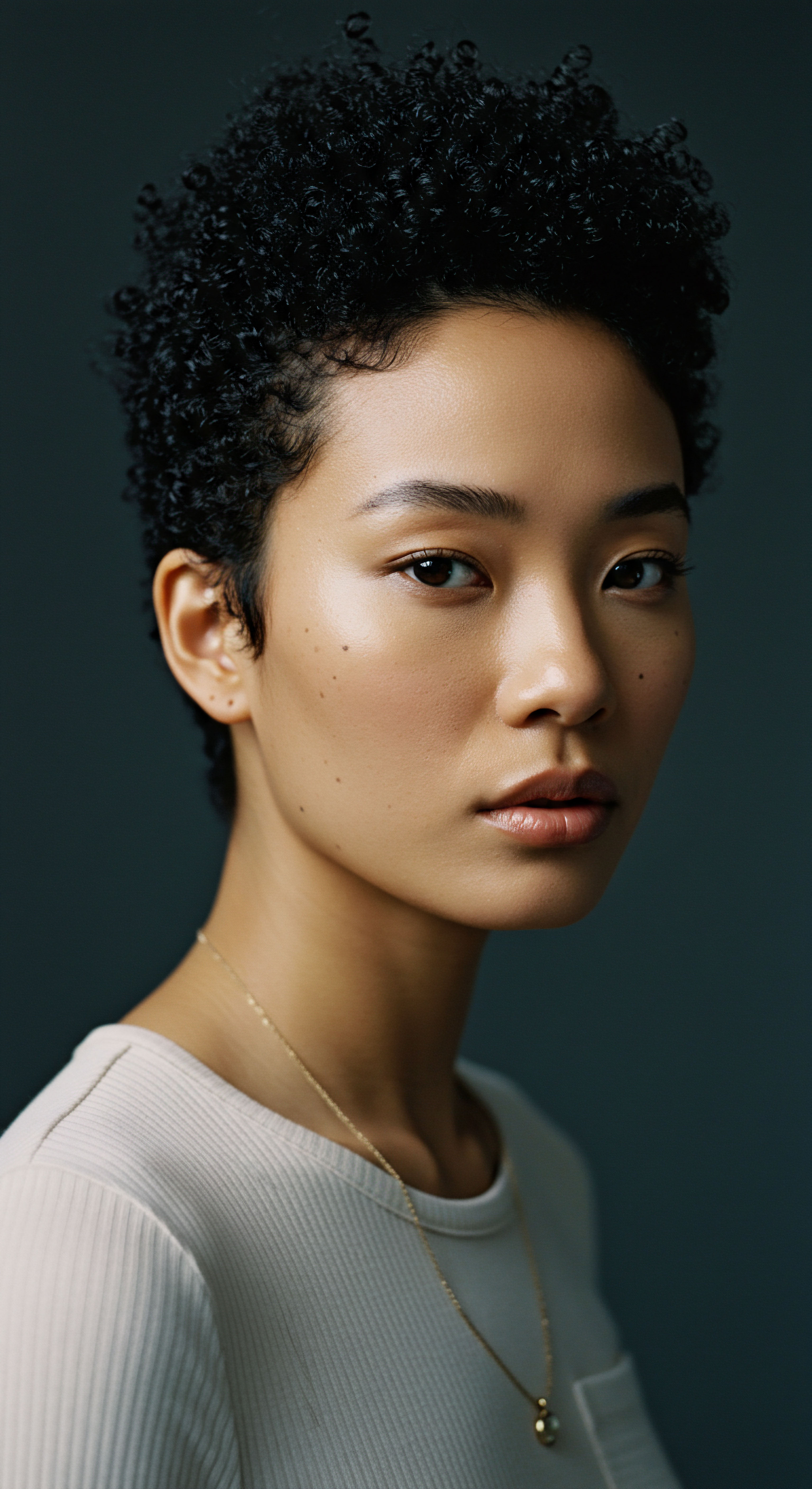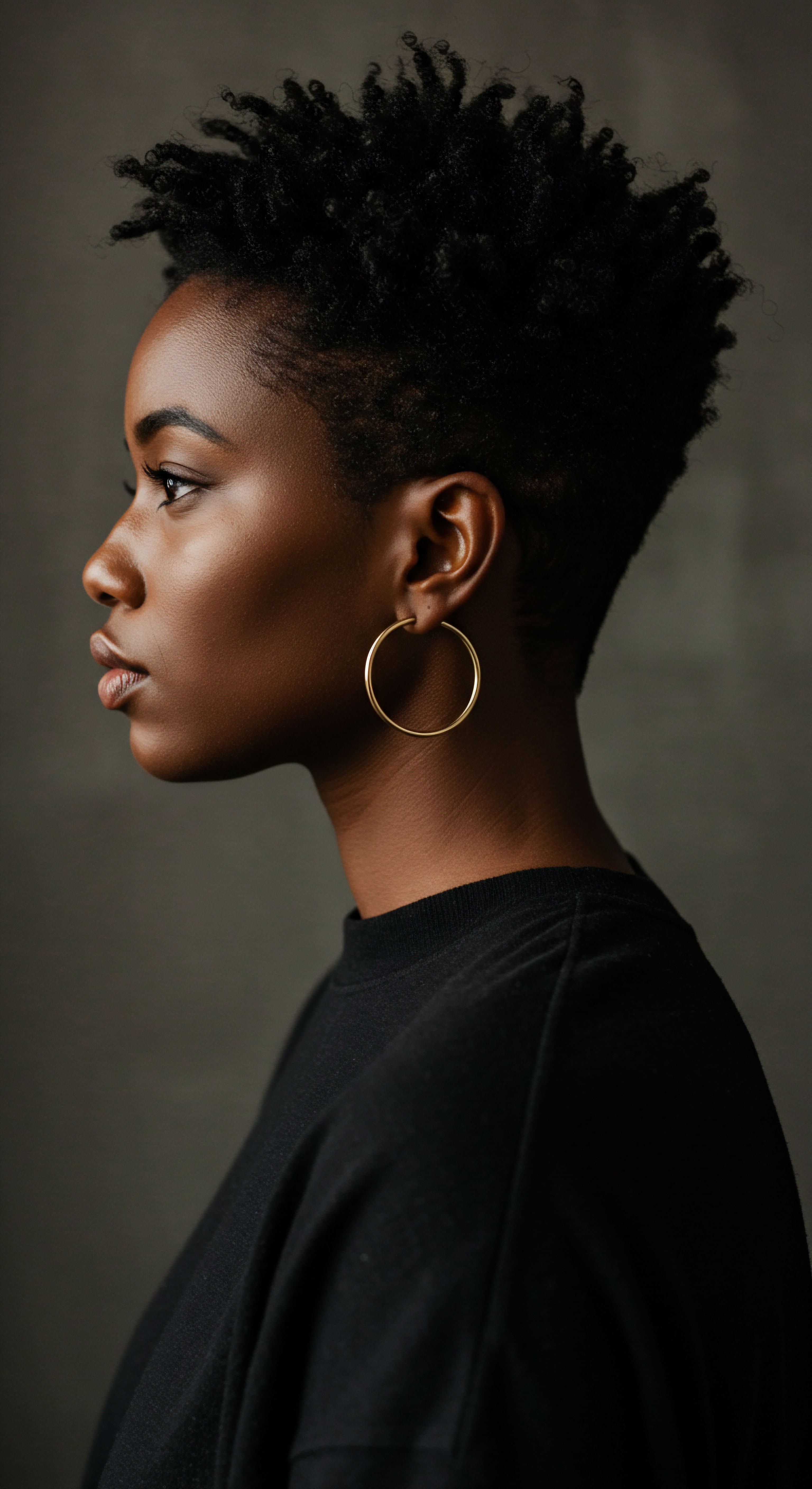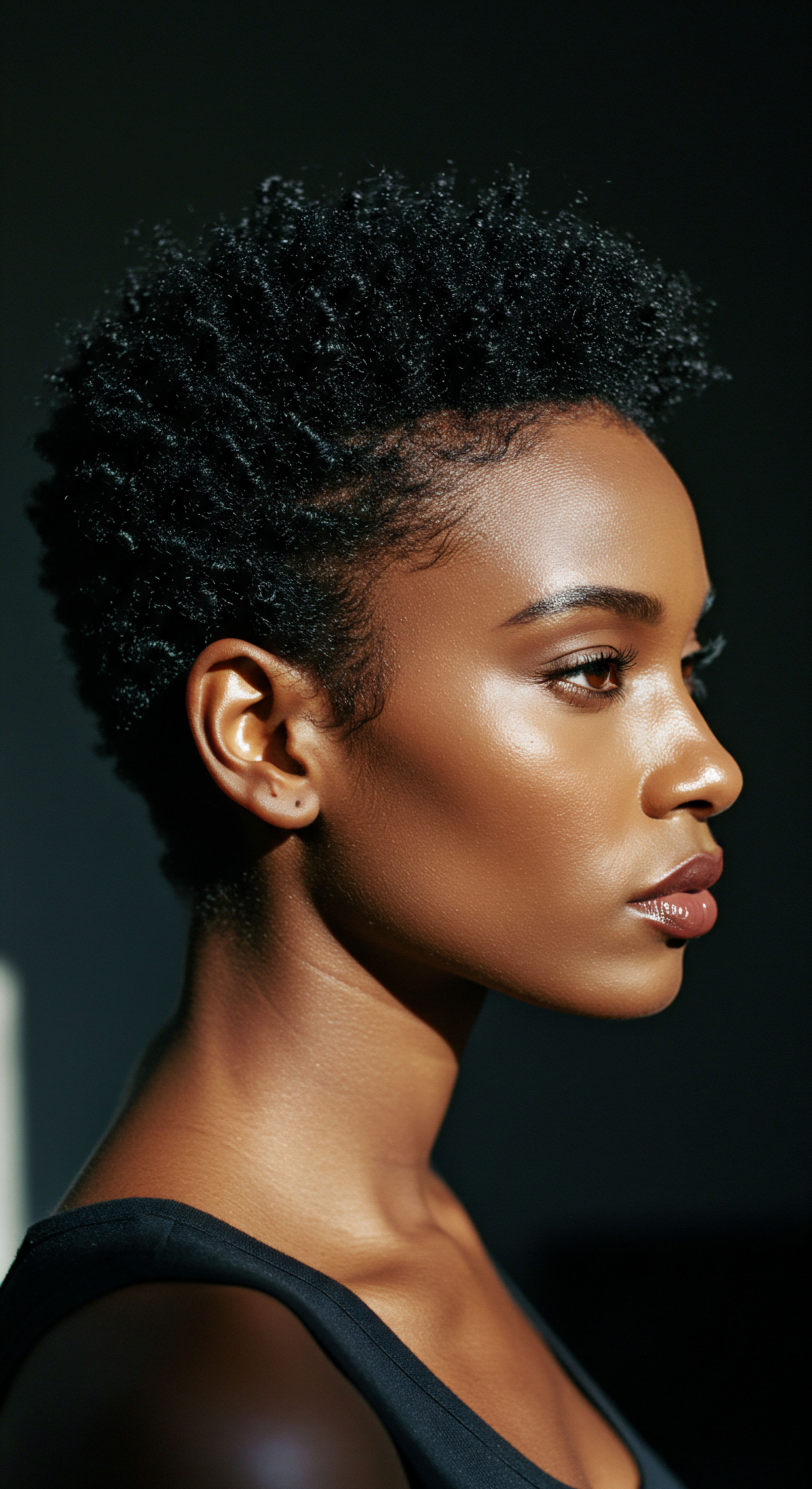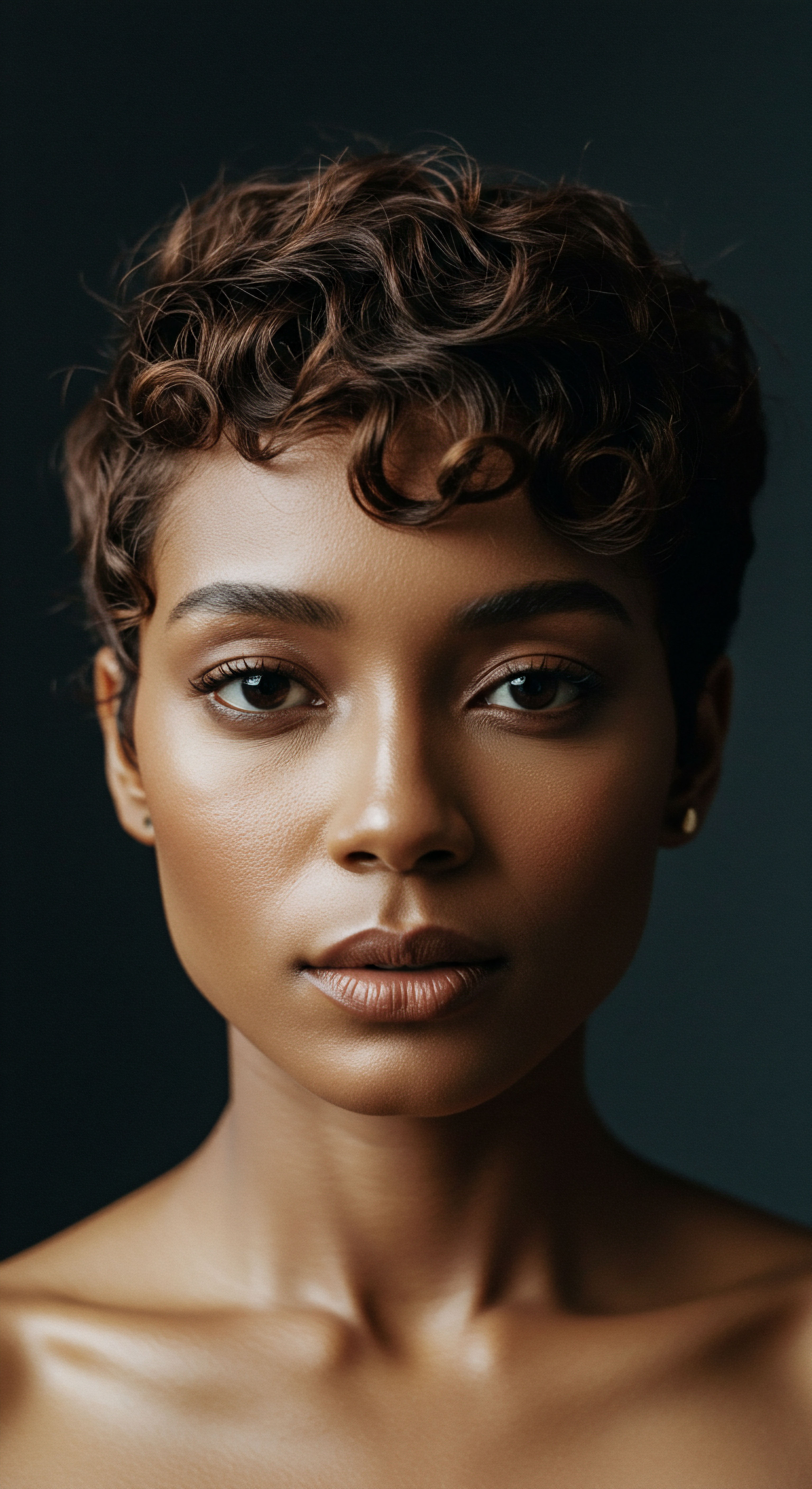
Roots
There is a quiet wonder in observing the myriad ways human expression finds its way into the world, often through channels we might consider everyday. Consider the strands that crown us, the very fibers of our being. For ancient African communities, these delicate filaments were never merely a covering; they were a living script, a vibrant chronicle woven into existence.
To truly grasp how ancient African hairstyles communicated social standing, one must first look beyond superficial appearances, delving into the profound connections between coiffure, communal life, and the very spirit of existence. It was a language spoken not in words, but in texture, length, and the careful arrangement of each individual coil and braid.
The story of hair in these societies begins at a foundational level, deeply intertwined with identity and belonging. Hair was considered a conduit for spiritual energy, a direct link to the divine and ancestral realms. Its proximity to the head, often viewed as the seat of the soul and wisdom, imbued it with sacred significance.
This spiritual connection elevated hair from a simple biological feature to a powerful medium for conveying information about an individual’s place within the collective. The condition of one’s hair, its vitality, and its meticulous upkeep often mirrored the spiritual health and social integrity of the person.
Ancient African hairstyles were a living script, a profound language of social standing, woven from texture, length, and arrangement.

Hair as a Visual Code
Before any spoken word, before any gesture, hair often announced who you were. It was a visible declaration of your affiliations, your achievements, and your very state of being. This visual code was understood universally within a given community, making it an undeniable form of social currency. From the earliest moments of life, hair played a part in marking passages and belonging.
- Age was often indicated by hairstyle. Younger individuals might wear simpler styles, while more elaborate or specific coiffures were reserved for elders, signifying accumulated wisdom and respect within the community.
- Marital Status could be clearly read. A maiden might wear her hair in one fashion, a married woman in another, and a widow in yet a third, each style conveying a distinct message about her availability, responsibilities, or current life stage.
- Lineage and Clan Affiliation were frequently expressed through particular braiding patterns, adornments, or the overall shape of the hairstyle. These stylistic markers served as a form of visual identification, allowing members of a group to recognize one another even across distances or among different communities.
The precise arrangement of hair, the partings, the number of braids, or the direction of the coils, all carried specific meaning. These were not arbitrary choices but adherence to established traditions that communicated status, origin, and even personal history. A particular part down the center might denote a certain social role, while a series of intricate cornrows could signify a special occasion or ritual.

The Weight of Adornment
Beyond the styling itself, the materials used to adorn hair spoke volumes. Shells, beads, cowries, precious metals, and natural pigments were not simply decorative; they were markers of wealth, trade connections, and social standing. The rarity of certain materials, their origin, and the skill required to incorporate them into a hairstyle all contributed to their value as status symbols.
Consider the use of gold, for instance, in regions rich with the metal. Its presence in a coiffure would immediately signal immense wealth and, by extension, high social standing. In other areas, cowrie shells, which served as a form of currency, would be meticulously woven into hair, their quantity reflecting the wearer’s economic power. These adornments were often heirlooms, passed down through generations, accumulating historical and symbolic value, further solidifying the wearer’s connection to an esteemed lineage.
The selection of adornments was also often tied to specific rituals or ceremonies. For a young woman transitioning into womanhood, certain beads might be incorporated into her hair, symbolizing her new status and readiness for marriage. For a chief or a spiritual leader, specific animal teeth or feathers might be used, reflecting their power, connection to the natural world, or their role as protectors of the community.

Ritual
To truly understand the deeper currents of how ancient African hairstyles articulated social standing, one must move beyond the static image and consider the dynamic, living processes involved. The creation of these styles was rarely a solitary act; it was a communal ritual, a meticulous dance of hands and intentions that spoke volumes about the wearer’s place within the social fabric. This section gently guides us into the practical wisdom embedded in these practices, reflecting on the daily and periodic efforts that shaped these powerful expressions of identity and status.
The time, skill, and communal effort poured into hair preparation were, in themselves, powerful indicators of status. Certain elaborate styles could take many hours, even days, to complete, often requiring the skilled hands of multiple individuals. Only those with significant leisure time, or the means to commission the labor of others, could maintain such complex coiffures. This intensive process was not merely about aesthetics; it was a performance of social capital, a tangible demonstration of one’s access to resources and community support.
The creation of ancient African hairstyles was a communal ritual, a meticulous dance of hands and intentions that spoke volumes about the wearer’s social place.

The Time Investment and Social Capital
The sheer duration required for certain elaborate styles served as a profound marker of status. Imagine a style that demanded not just hours, but days, of careful braiding, twisting, or sculpting. This was not a quick morning routine; it was a commitment of time and resources.
For example, among some West African groups, particularly in pre-colonial eras, the preparation of ceremonial hairstyles for important rites of passage or leadership investitures could extend over several days. This required the continuous presence and skill of dedicated stylists, often older women or specialized practitioners, whose labor was compensated through reciprocal community service, goods, or prestige.
This significant investment of time and specialized labor underscored the wearer’s elevated position. It demonstrated that they were not burdened by daily subsistence tasks, allowing them the luxury of such an extensive beauty ritual. Furthermore, the presence of multiple skilled hands working on one’s hair was a public display of social connection and influence.
It showcased the wearer’s ability to command the time and talent of others, reinforcing their standing within the communal hierarchy. The hair became a living monument to their social capital.
Consider the extensive labor involved in creating and maintaining some of the most intricate styles. For instance, the traditional Fulani braids, often adorned with cowrie shells and amber beads, could take a full day to install and then required careful upkeep. The weight and complexity alone would signify that the wearer had assistants or family members dedicated to their presentation. This is supported by anthropological studies of West African communities where the labor of hairstyling was often a shared, intergenerational activity, but the ability to receive such labor without needing to reciprocate immediately was a clear sign of higher standing.

Adornments and Ritual Purity
The materials incorporated into these ritualistic hairstyles often held symbolic meaning beyond their monetary value. Certain plants, herbs, or clays were applied not just for aesthetic purposes but for their perceived spiritual or medicinal properties. These applications could signify ritual purity, protection, or a connection to specific deities or ancestral spirits. The knowledge of which materials to use, and how to prepare them, was often passed down through generations, guarded by those with specialized wisdom.
In some communities, specific oils or concoctions were applied to the hair during naming ceremonies, marriages, or funerals. These applications were not merely cosmetic; they were acts of blessing, purification, or mourning. A woman preparing for marriage might have her hair styled with special clays that signified fertility and blessing, while a person in mourning might wear a style that involved dusting their hair with ash, a visible sign of their grief and detachment from worldly concerns. These ritualistic applications transformed the hair into a living canvas of life’s transitions and social responsibilities.
The specific patterns themselves were often tied to ritual. The direction of braids, the number of twists, or the inclusion of certain partings could replicate sacred geometric forms or symbols associated with specific deities or ancestral lineages. For instance, among some groups, a circular pattern might represent unity or the cyclical nature of life, while a linear pattern could symbolize a journey or a connection to the earth. These patterns were not random but carefully chosen to align the wearer with cosmic forces or communal beliefs, reinforcing their place within the spiritual and social order.
| Hair Practice Elaborate Ceremonial Braids |
| Time Investment Multiple days, skilled stylists |
| Social Implication High social standing, access to labor and leisure |
| Hair Practice Application of Sacred Clays |
| Time Investment Specific ritual timing |
| Social Implication Ritual purity, spiritual connection, life transition |
| Hair Practice Inclusion of Rare Adornments |
| Time Investment Acquisition through trade or inheritance |
| Social Implication Wealth, lineage, political connections |
| Hair Practice These practices demonstrate the profound connection between hair, ritual, and social hierarchy. |

Relay
How deeply can a single element of personal presentation speak to the intricate structures of a society? As we move into this section, we seek a more sophisticated, multi-dimensional exploration of how ancient African hairstyles communicated social standing. Here, the strands become conduits for profound insight, where biological realities, psychological undercurrents, social norms, and cultural narratives converge.
We are invited to consider the less apparent complexities, the subtle yet powerful ways hair served as a dynamic system for relaying information about an individual’s place within the communal tapestry. This exploration transcends simple categorizations, inviting us to see hair as a vibrant, interconnected expression of identity and power.
The very texture and growth patterns of African hair, often celebrated for its versatility and resilience, presented a unique biological canvas for social articulation. Unlike straight hair, which often hangs with less structural possibility for intricate, self-supporting forms, textured hair can be molded, coiled, and sculpted into gravity-defying shapes that maintain their form for extended periods. This inherent quality allowed for the creation of complex, durable styles that could remain intact for weeks or even months, serving as persistent visual statements of status, role, and identity. The ability to maintain such elaborate styles spoke to both the skill of the stylist and the dedication of the wearer, reflecting a sustained commitment to social presentation.
Hair served as a dynamic system for relaying information about an individual’s place within the communal tapestry.

Beyond Appearance What Did Hair Communicate?
The communication conveyed by ancient African hairstyles extended far beyond simple aesthetic preference; it was a sophisticated semiotic system. A style could indicate not only one’s current social position but also historical events, alliances, and even future aspirations. For instance, certain hairstyles might be adopted during periods of war, signifying a warrior’s readiness or a community’s resolve.
Conversely, styles associated with peace and prosperity might be worn during times of abundance. This fluidity of meaning meant that hair was not a static badge but a dynamic, evolving narrative.
The communal nature of hairstyling sessions also played a critical role in reinforcing social bonds and transmitting cultural knowledge. These sessions were often spaces for storytelling, education, and the reinforcement of social norms. As elders meticulously styled the hair of younger generations, they would impart wisdom, historical accounts, and lessons about communal values.
This act of styling became a pedagogical ritual, where the physical act of shaping hair was inseparable from the shaping of identity and understanding of one’s place in society. The very process of having one’s hair styled, especially by a respected elder or a skilled professional, could itself be a marker of honor and connection to communal wisdom.
The meticulous care and presentation of hair also spoke to a deeper psychological aspect ❉ self-respect and communal pride. In many African societies, the body was viewed as a sacred vessel, and its adornment was an act of honoring the self, the community, and the ancestors. A well-maintained, artfully styled head of hair was a visible manifestation of an individual’s diligence, discipline, and respect for cultural traditions.
Conversely, unkempt or neglected hair could, in certain contexts, signify a state of mourning, illness, or social ostracization. This underscores the profound psychological weight placed on hair as a mirror of one’s inner state and outer standing.

The Economics of Hair and Prestige
The economic dimension of hair as a status symbol in ancient Africa was significant, extending beyond the mere possession of valuable adornments. It encompassed the cost of labor, the trade networks for specific materials, and the specialized knowledge required for certain styles. This economic interplay contributed to the prestige associated with particular coiffures.
A fascinating insight comes from the study of pre-colonial West African societies, where certain elaborate hairstyles, especially those involving the careful integration of precious metals like gold or rare shells, were not merely time-consuming but represented a considerable economic outlay. Anthropological research suggests that the maintenance of such styles often necessitated a dedicated “hair economy” where skilled practitioners were compensated not just in goods, but often through social capital, favors, or reciprocal labor arrangements within the community. For example, among some Akan groups, the use of gold dust or intricate gold weights in hair ornamentation was directly tied to the individual’s wealth and political power, reflecting their control over trade routes or access to mining resources. The ability to display such wealth on one’s head was a public declaration of economic prowess and social dominance.
Furthermore, the materials themselves, such as specific types of beads from distant lands or rare feathers, indicated participation in extensive trade networks. To possess such items, and to have them skillfully incorporated into one’s hair, implied not only wealth but also influence and connections that stretched beyond immediate village boundaries. This tangible display of external connections through hair became a powerful symbol of an individual’s standing within a broader regional or even continental context.
- Skilled Labor was a premium commodity. Complex styles required artisans whose expertise was honed over years, often passed down through familial lines. Access to these master stylists was a mark of privilege.
- Material Acquisition involved extensive trade routes. Rare shells, beads, and metals were often sourced from distant regions, making their presence in a hairstyle a testament to one’s wealth and connections.
- Maintenance Demands reinforced status. The upkeep of elaborate styles was continuous, requiring time, resources, and often the ongoing assistance of others, further solidifying the wearer’s elevated position.
| Economic Factor Access to Skilled Labor |
| Hair Manifestation Intricate, long-lasting styles |
| Social Message Conveyed Leisure, wealth, influence over community resources |
| Economic Factor Control over Trade Networks |
| Hair Manifestation Rare, imported adornments (e.g. specific beads, metals) |
| Social Message Conveyed Broad connections, economic power, high social standing |
| Economic Factor Inherited Wealth |
| Hair Manifestation Heirloom adornments passed down generations |
| Social Message Conveyed Connection to esteemed lineage, historical prestige |
| Economic Factor The economic investment in hair directly correlated with an individual's social and political standing. |

Reflection
As we gently conclude our exploration of ancient African hairstyles, a profound truth settles ❉ these magnificent expressions were far more than mere aesthetics. They were vibrant, breathing archives of human experience, meticulously crafted to tell stories of lineage, power, and belonging. Each twist, each braid, each carefully placed adornment was a deliberate stroke in a living portrait, reflecting not only the individual but the entire communal spirit.
The legacy of these practices reminds us that beauty, at its deepest, is often a profound conversation between self and society, a delicate dance of identity articulated through the very fibers that crown us. What might our own contemporary adornments truly say about us, if read with such an ancestral eye?

References
- Sieber, Roy, and Frank Herreman. Hair in African Art and Culture. Museum for African Art, 2000.
- Tarlo, Emma. Entanglement ❉ The Secret Lives of Hair. Oneworld Publications, 2016.
- Byrd, Ayana, and Lori L. Tharps. Hair Story ❉ Untangling the Roots of Black Hair in America. St. Martin’s Press, 2014.
- Opoku, Agyeman. African Traditional Religion ❉ An Introduction. African World Press, 1997.
- Mercer, Kobena. Welcome to the Jungle ❉ New Positions in Black Cultural Studies. Routledge, 1994.
- Spring, Christopher. African Textiles Today. British Museum Press, 2012.
- Thompson, Robert Farris. Flash of the Spirit ❉ African and Afro-American Art and Philosophy. Vintage Books, 1984.
- Drewal, Henry John, and Margaret Thompson Drewal. Gelede ❉ Art and Female Power Among the Yoruba. Indiana University Press, 1990.